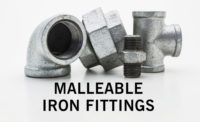Domestic Pipe, Fittings Get Little 2003 Relief
These conclusions can be drawn from the International Trade Commission's “Steel Monitoring Developments In The Domestic Industry” report in September 2003. As shown in the adjacent chart, imports declined from 42.7% of U.S consumption in the year before the tariffs were imposed to 37.1% in the following year. Note, however, that imports from “noncovered sources,” i.e., nations excluded from the 203 tariffs for various reasons, increased significantly. Meantime, U.S. production increased just a bit in tonnage while capacity utilization continued to drop.
In the fittings category, U.S. consumption dropped quite a bit from both imports and domestic sources, owing to a market slump more than any tariff remedies.
Pipe producers maintained “that the section 203 measure has had very little effect on the domestic welded pipe industry's condition or its investment decisions. Respondents contend that the domestic industry's condition is directly influenced by factors other than the section 203 measures, most notably the overall economy, overcapacity, and raw material prices,” reported the ITC.
“With respect to fittings, respondents contend that the domestic industry's efforts to make a positive adjustment to import competition have been inadequate … They further contend that the domestic industry's financial performance is not dependent upon adjustment efforts, nor in fact is its overall condition correlated to imports of fittings,” said the ITC report.
Looking for a reprint of this article?
From high-res PDFs to custom plaques, order your copy today!






